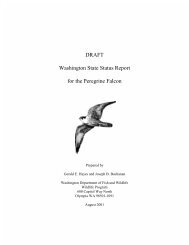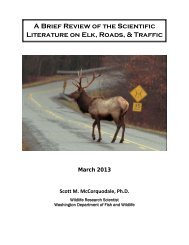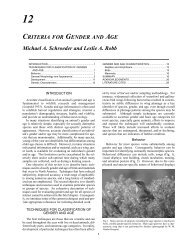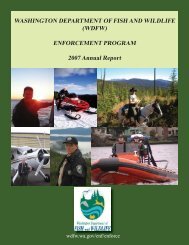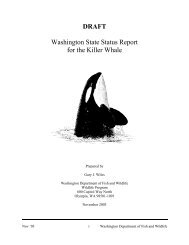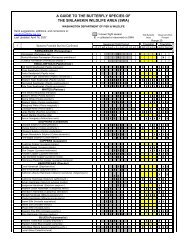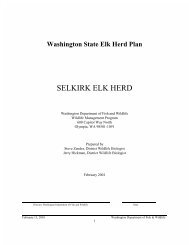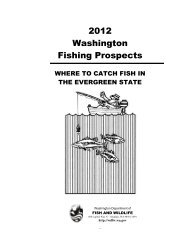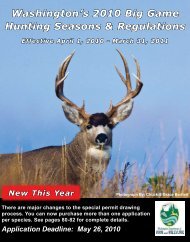June 10 - Washington Department of Fish & Wildlife
June 10 - Washington Department of Fish & Wildlife
June 10 - Washington Department of Fish & Wildlife
Create successful ePaper yourself
Turn your PDF publications into a flip-book with our unique Google optimized e-Paper software.
<strong>Wildlife</strong> Program<br />
Week <strong>of</strong> <strong>June</strong> <strong>10</strong>-16, 2013<br />
WILDLIFE DIVERSITY DIVISION<br />
GOAL 1: CONSERVE AND PROTECT NATIVE FISH AND WILDIFE<br />
Island Marble Conservation: Ann Potter, <strong>Wildlife</strong> Diversity Biologist, and Dave Hays,<br />
Diversity Restoration Ecologist, participated in discussions with San Juan Island National<br />
Historical Park (SJINHP), U.S. <strong>Fish</strong> and <strong>Wildlife</strong> Service (USFWS), and University <strong>of</strong><br />
<strong>Washington</strong>, to evaluate Island Marble butterfly demographics and threats. Discussion focused<br />
on determining immediate steps to reduce threats, including possibility <strong>of</strong> initiating a captiverearing<br />
effort. Island Marble is a candidate for state listing and currently under review by the<br />
USFWS for possible federal listing. The number <strong>of</strong> populations and individuals has declined<br />
significantly over the last five years; most butterflies now occur within SJINHP. Adult butterfly<br />
numbers are very low this year; a search for eggs and larvae located fewer than <strong>10</strong>0.<br />
Given (1) low number <strong>of</strong> individuals, (2) existence <strong>of</strong> a rearing protocol that demonstrably<br />
support survivorship rates far above wild conditions, and (3) participation from the most<br />
experienced Island Marble care expert; participants agreed on park staff initiating a small<br />
captive-rearing effort. Additional steps are underway to reduce threats by installing fencing and<br />
temporary cages around host plants with eggs/larvae to reduce deer herbivory.<br />
REGION 1<br />
Wolf Management<br />
District 1: District <strong>Wildlife</strong> Program staff deployed self-activated cameras within Game<br />
Management Unit (GMU) <strong>10</strong>5 (the Wedge) to document potential wolves and/or grizzlies in the<br />
area. Documentation <strong>of</strong> new wolf packs is a priority in the District. In the coming weeks cameras<br />
will be deployed in other areas with reported wolf activity, but unconfirmed wolf packs. Cameras<br />
will be checked on a regular basis and all species captured with photos will be recorded. District<br />
<strong>Wildlife</strong> Biologist Dana Base met with Trent Roussin, one <strong>of</strong> the two recently hired wolf<br />
trapping specialists, and helped him with logistical issues relative to his work as well as set-up <strong>of</strong><br />
a work space and access to the District <strong>of</strong>fice.<br />
Conflict Specialist Shepherd participated in the wolf conference call with the carnivore section<br />
lead Donny Martorello discussing the data sharing agreements and other wolf issues. Conflict<br />
Specialist Shepherd went to the Wedge with Biologist Prince, Technician Bendixen, and a<br />
contractor. Time was spent looking for sign, no fresh sign was observed, and deploying cameras<br />
in the Churchill grazing allotment on the Colville National Forest.<br />
Conflict Specialist Shepherd met with the Stevens County Cattlemen’s Association president and<br />
media specialist and discussed data sharing among livestock producers. Conflict Specialist
Shepherd produced maps <strong>of</strong> Smackout wolf locations and discussed them with <strong>of</strong>ficers, a range<br />
rider, and a rancher throughout the week. Conflict Specialist Shepherd met with Regional and<br />
local Conservation Northwest members to discuss assistance with range riding, hazing, and other<br />
objectives targeted at reducing wolf – livestock conflicts on a field trip to Smackout Meadows.<br />
The outcome was productive and the field trip included a preliminary slide show.<br />
Conflict Specialist Shepherd flew in a fixed wing plane and located wolves in the Smackout,<br />
Huckleberry, Salmo, and Diamond wolf packs. Conflict Specialist Shepherd discussed the<br />
Wedge wolf situation and the Churchill grazing allotment with Regional Director Pozzanghera.<br />
Conflict Specialist Shepherd communicated with allotment holders in the Wedge.<br />
District 3: District Biologist Wik placed additional cameras throughout the eastern Blue<br />
Mountains this week, including in an area <strong>of</strong> a report <strong>of</strong> an injured pup. Conflict Specialist<br />
Rasley and Assistant District Biologist Vekasy boxed up the two wolf scat samples we collected<br />
north <strong>of</strong> Waitsburg and sent them in for DNA verification.<br />
GOAL 1: CONSERVE AND PROTECT NATIVE FISH AND WILDIFE<br />
<strong>Wildlife</strong> Management<br />
Spokane Goose Banding Project: Biologists<br />
Ferguson and Atamian worked with WDFW<br />
Waterfowl Biologist Erin Wehland and<br />
Assistant Biologist Warren Becker along with<br />
<strong>10</strong> other hard working volunteers. The group<br />
captured geese at three locations in Spokane:<br />
Hangman Golf course, Gonzaga University and<br />
Liberty Lake. The group was very successful<br />
banding 121 and capturing over 140 geese,<br />
which included recaptures and goslings too<br />
young to band.
Blue Mountains Golden Eagle<br />
monitoring: Assistant District<br />
Biologist (ADB) Vekasy conducted<br />
aerial survey <strong>of</strong> Priority II eagle<br />
territories within the influence <strong>of</strong><br />
wind power development. Two<br />
territories had nestlings within 80%<br />
<strong>of</strong> fledging age (considered<br />
successful), and one had adults<br />
present but no indication <strong>of</strong> any<br />
nestlings. Also observed Priority I<br />
nest at Cummings Creek, which had<br />
failed, but found a new<br />
territory/nest south <strong>of</strong> Cummings<br />
Creek with surprisingly young<br />
nestling for this area at this time <strong>of</strong><br />
year. Another new territory/nest this year in the Tucannon river drainage had a single 8 week-old<br />
nestling. District Biologist Wik checked one golden eagle nest in upper Alpowa Creek this week<br />
that had two nestlings in it. Both were old enough to be considered successful.<br />
<strong>Wildlife</strong> Areas<br />
Sherman Creek <strong>Wildlife</strong> Area Prescribed Burning – The prescribed burning component <strong>of</strong><br />
the habitat improvement project on the Sherman Creek <strong>Wildlife</strong> Area continued this week. The<br />
burn window was limited this week by weather, but the crew did manage to treat approximately<br />
17 acres. Burning was conducted from 6:00 p.m. to 12:00 a.m. on Wednesday night, and again<br />
on Thursday from 11:00 a.m. to 2:30 p.m.<br />
Night burning in the Cougar Unit at Sherman Creek <strong>Wildlife</strong> Area
Chief Joseph <strong>Wildlife</strong> Area – Wildfire: <strong>Wildlife</strong> Area Manager Bob Dice responded to a<br />
report <strong>of</strong> a wildfire on the Chief Joseph <strong>Wildlife</strong> Area on Saturday <strong>June</strong> 8. Crews from Blue<br />
Mountains Fire District #1(BMFD), U.S. Forest Service (USFS), and the <strong>Department</strong> <strong>of</strong> Natural<br />
Resources (DNR) also responded initially. Due to jurisdictional uncertainties, there was quite a<br />
bit <strong>of</strong> confusion at the beginning <strong>of</strong> the fire on where the fire could be fought and by whom. The<br />
private residences along the Grande Ronde have no fire protection, yet this is where the fire<br />
came from. BMFD’s protection boundary covers most <strong>of</strong> the wildlife area north <strong>of</strong> the Grande<br />
Ronde. Bureau <strong>of</strong> Land Management (BLM) staff out <strong>of</strong> Vale, Oregon and USFS staff would<br />
only protect BLM land and could not engage the fire on the west end where BMFD crews were<br />
working. There were a few instances where homeowners were screaming at BMFD crews for<br />
assistance as fire approached their residences. BMFD refused assistance due to the homeowner’s<br />
opposition to join the fire district when given the opportunity to be included.<br />
This fire burned just less than 2,500 acres. There were 12 miles <strong>of</strong> fire lines. Some bighorn<br />
lambing habitat on WDFW land was burned. It is unknown how the bighorns faired during this<br />
fire. DNR took over command <strong>of</strong> the fire on Tuesday to the relief <strong>of</strong> BMFD crews who were<br />
exhausted. The IC3 team immediately ordered additional resources on Tuesday and by Thursday;<br />
the fire was pretty much out. All fire crews and the incident management team left the area<br />
Friday morning. During this fire there were five different helicopters used for suppression.<br />
Without air support, this fire would have burned literally thousands more acres <strong>of</strong> land.<br />
Though much <strong>of</strong> the vegetation was green, it did burn in this fire. Green is just a color as we<br />
learned during this fire. The wildlife area provided a five-ton military cargo truck with a 1,800<br />
gallon tank for engine support and dust control. The fire camp was located at buildings on Rock<br />
Dixon’s land adjacent to the wildlife area. Dixon’s staff made a significant contribution towards<br />
fighting the fire. Mr. Dixon also volunteered services <strong>of</strong> his private helicopter, but it turned out<br />
the pilot was not available.<br />
Fire camp was located at these buildings with burned WDFW land in the background.
Helicopter view <strong>of</strong> burned WDFW land<br />
The 98 Delta, a private contract helicopter from Eagle Helicopters <strong>of</strong> Spokane, dipped water<br />
near Heller Bar. Pilot Robby McKenzie did an outstanding job suppressing fire and working<br />
with firefighters on the ground.
REGION 2<br />
Wolves<br />
Wenatchee Wolves: No activity to report. Sightings and reports have dropped <strong>of</strong>f recently. The<br />
Hurd Ranch has released cattle from the calving pens and they are back on the range. Payments<br />
have been made to the Hurd Ranch based on the current agreement.<br />
GOAL 1: CONSERVE AND PROTECT NATIVE FISH AND WILDIFE<br />
<strong>Wildlife</strong> Management<br />
Pygmy Rabbit Kits Released to Wild: Research Scientist Becker, Diversity Division Manager<br />
Gardner, Lands Division Manager Sprague, and a team <strong>of</strong> staff and volunteers released an<br />
additional 41 pygmy rabbit kits from all breeding enclosures to the wild at Sagebrush Flat<br />
<strong>Wildlife</strong> Area. The kits were weighed, sexed, treated for parasites, sampled for genetics, and<br />
some were fitted with glue-on transmitters to track their movements post-release. The next kit<br />
round up will be on <strong>June</strong> 24 at Sagebrush Flat <strong>Wildlife</strong> Area.<br />
Left: A pygmy rabbit kit is held to obtain a tissue sample from its ear. Right: A kit munches on<br />
grass and shows <strong>of</strong>f its new ear punch.<br />
Pygmy Rabbit Identification Guide: Research Scientist Becker distributed a guide to biologist<br />
colleagues and Region 2 customer service aimed at identifying pygmy rabbits and distinguishing<br />
differences between pygmy rabbits and cottontails. The guide is aimed at helping staff answer<br />
inquiries from the public that come in frequently during the spring when juvenile cottontails are<br />
misidentified as pygmy rabbits.<br />
<strong>Wildlife</strong> Areas<br />
Barker Canyon Fire: Manager Fitzgerald inspected Pastures 2 and 3 that burnt last July as part<br />
<strong>of</strong> the Barker Canyon Complex Fire. May showers brought abundant <strong>June</strong> flowers, and good<br />
grass recovery, with abundant seed production. Approximately 33% <strong>of</strong> the Columbia Basin
<strong>Wildlife</strong> Area Ponderosa Pine forest was damaged. One tree was killed, but the other pine is<br />
expected to survive. Sagebrush cover in a large portion <strong>of</strong> Pasture 2 was heavy and as a result the<br />
fire burned much hotter and recovery will take longer.<br />
Above: Taken from the burn line. Below left: Typical sagebrush cover, Pasture 2. Below right:<br />
Pasture 2 after the burn.<br />
See if you can find the<br />
fawn? A doe found a<br />
small patch <strong>of</strong> green the<br />
next day within the Cougar<br />
Unit to drop its fawn<br />
where scents were masked<br />
by the smoke. This is a<br />
wide angle view <strong>of</strong> the<br />
fawn in the Cougar Burn<br />
Unit. There is smoldering<br />
duff within one foot <strong>of</strong> it<br />
so warmth may have<br />
played a role in where the<br />
doe dropped the fawn as<br />
well.
GOAL 3: PROMOTE A HEALTHY ECONOMY, PROTECT COMMUNITY CHARACTER,<br />
MAINTAIN AN OVERALL HIGH QUALITY OF LIFE, AND DELIVER HIGH-QUALITY<br />
CUSTOMER SERVICE<br />
<strong>Wildlife</strong> Areas<br />
Heads Up -- Rocky Ford Foot Bridge: After receiving hazard complaints regarding the<br />
aluminum footbridge at the Rocky Ford <strong>Fish</strong> Hatchery Site, Access Manager Josh Harmon<br />
inspected the bridge and contacted Construction Project Coordinator Casey Davidson from the<br />
Capital and Asset Management Program (CAMP) who had inspected both the aluminum and the<br />
wooden bridge on <strong>June</strong> 12 and recommended closing them. The shoreline supporting the bridge<br />
abutments has eroded to the point that the abutments have dropped, and the abutment supports<br />
are hanging. Manager Fitzgerald met Josh on site to determine what we could do to repair the<br />
bridges. Access Staff can repair the abutments for the wooden bridge, but repairs to the<br />
aluminum bridge are beyond our capability and we’ll have to close it for safety reasons. The<br />
closure will surely cause controversy as the bridges are approximately three-quarters <strong>of</strong> a mile<br />
apart and the aluminum bridge accesses a very popular fishing spot.<br />
Bridge<br />
Hanging Abutment Supports<br />
Tonasket-Oroville Upward<br />
Bound Program: Assistant<br />
manager Haug and<br />
silviculturist Brett hosted the<br />
<strong>Washington</strong> State Universitybased<br />
Upward Bound Program<br />
(pictured below). The<br />
<strong>Washington</strong> State University<br />
(WSU) Upward Bound is a<br />
project designed to provide<br />
educational assistance and<br />
support to eligible high school<br />
students to complete high<br />
school and continue on to
college. Students accepted into the project will receive academic support, tutoring, mentoring,<br />
career exploration, counseling, and the opportunity to participate in summer programs at WSU-<br />
Pullman. The nine students from Tonasket and Oroville participated in data collection using GPS<br />
and analysis using ArcGIS s<strong>of</strong>tware. They also learned about the Sinlahekin <strong>Wildlife</strong> Area, its<br />
history and current management. They will return in July to further explore the field <strong>of</strong> Natural<br />
Resource Science and Management.<br />
Students in Upward Bound are four times more likely to earn an undergraduate degree than<br />
those students from similar backgrounds who did not participate.<br />
Access Site Work: Access staff spent a day at Roses Lake. Fifty yards <strong>of</strong> gravel was delivered<br />
to two large potholes from a previous washout that would suck in a car tire very easily, while the<br />
rest was spread over roadway. Another 50 yards is needed to complete the whole site.<br />
REGION 3<br />
GOAL 1: CONSERVE AND PROTECT NATIVE FISH AND WILDIFE<br />
<strong>Wildlife</strong> Management<br />
Jackrabbit Surveys: Biologist Gregory joined WDFW Biologists from Regions 1 and 3, the<br />
U.S. <strong>Fish</strong> and <strong>Wildlife</strong> Service, and the Colville Tribe for training on jackrabbit DNA collection.<br />
This summer, hundreds <strong>of</strong> sites will be visited throughout potential jackrabbit habitat to search<br />
for pellets that will provide DNA for determining population distribution and connectivity.
Above: Searching shrub-steppe habitat for jackrabbit sign. Below: Jackrabbit habitat near<br />
Lower Crab Creek.<br />
North American Wetlands Conservation Act (NAWCA) Grant preparation: Biologists<br />
Gregory, Bjornstrom, Ross and Buser met with Tina Blewett from Ducks Unlimited to discuss<br />
continued development <strong>of</strong> the Mid-Columbia NAWCA Grant request. The meeting was a great<br />
opportunity for clarification <strong>of</strong> the application guidelines and progress toward completion <strong>of</strong> the
equest. Much work remains before the deadline in early 2014. Adding a land acquisition or<br />
conservation easement to the package for match would make the application more competitive.<br />
The group also needs to identify more projects as targets for the one million dollar grant.<br />
Canada goose banding: Biologist Gregory was part <strong>of</strong> a team that included several members <strong>of</strong><br />
the <strong>Wildlife</strong> and <strong>Fish</strong> Programs, the <strong>Washington</strong> Waterfowl Association, and other volunteers<br />
assisting Waterfowl Specialist Wehland with the 7 th annual goose banding effort in the Tri-<br />
Cities. The dedicated crew captured 152 birds at three parks along the Columbia River in<br />
Kennewick and Pasco. Of the total birds captured, <strong>10</strong>% were recaptures from previous years.<br />
The information collected from returned bands is used to track goose movements and survival<br />
and helps biologists set hunting seasons.<br />
Biologists Bernatowicz and Moore also assisted in the goose banding project within District 8,<br />
where roughly <strong>10</strong>0 birds were banded.<br />
Approximately 80 geese wait to be banded at Columbia Park in Kennewick.<br />
REGION 4<br />
GOAL 1: CONSERVE AND PROTECT NATIVE FISH AND WILDIFE<br />
<strong>Wildlife</strong> Management<br />
Golden Eagle Survey: Biologist DeBruyn was finally able to make it into a site that has had<br />
snow issues preclude a ground visit. He found two adult eagles at the site but wasn’t able to see
the actual nest. It is only the second golden eagle site that has been found to be occupied in<br />
District 14 this year.<br />
Snoqualmie Bear Project:<br />
Biologist Smith assisted<br />
Graduate Student Welfelt<br />
with checking barbed-wire<br />
bear hair corrals. Bear hair<br />
samples were collected at<br />
50% <strong>of</strong> the 27 corrals<br />
checked. Several corrals<br />
produced over 20 samples,<br />
with 46 being collected at a<br />
single corral. All corrals<br />
were refurbished and fresh<br />
lure added. The corrals will<br />
be checked again and<br />
removed in <strong>10</strong> days.<br />
A Black Bear hair sample<br />
was caught by a barb <strong>of</strong> a<br />
corral during the<br />
Snoqualmie Bear Project.<br />
U.S. Forest Service (USFS) Administrative Access Meeting: Biologist Danilson met with the<br />
new District Ranger and <strong>Wildlife</strong> Biologist for the Baker District <strong>of</strong> the Mount-Baker<br />
Snoqualmie National Forest. The purpose <strong>of</strong> the meeting was to develop a more streamlined<br />
process for WDFW to get administrative access for work in areas that are otherwise closed to the<br />
public. Several road systems on the Baker District have wildlife-related winter closures and are<br />
thus gated. Danilson provided USFS staff with background on the closures and updated<br />
information related to population size and distribution <strong>of</strong> the species being protected. As a result<br />
<strong>of</strong> the meeting, the process for wildlife and fisheries staff to obtain access should be much less<br />
burdensome.<br />
Oregon Spotted Frog Project: Biologist Danilson reviewed plans for a proposed project in<br />
Whatcom County that has the potential to impact one <strong>of</strong> the larger breeding sites <strong>of</strong> Oregon<br />
spotted frogs. Danilson also discussed the project with the project proponent from the Natural<br />
Resource Conservation Service, WDFW Habitat Biologist Cole, and WDFW Biologist Hallock<br />
to evaluate potential project impacts and discuss potential next steps. Biologist DeBruyn<br />
transcribed and submitted this year’s egg mass surveys to the WDSM.<br />
US Navy Pika Surveys: Biologist Milner met with Navy staff for a kick-<strong>of</strong>f meeting for the<br />
pika surveys at Jim Creek Navy property. The reporting process for progress on the contract was<br />
reviewed, as were questions regarding access, safety, and the timing <strong>of</strong> the first visit to the Jim<br />
Creek installation to meet staff and review the site.
Bald Eagle Data Management Support: Assistant District Biologist Cyra continued to work<br />
with Biologist Stinson <strong>of</strong> the U.S. <strong>Fish</strong> and <strong>Wildlife</strong> Service (USFWS) about specifics <strong>of</strong> the<br />
boundaries and history <strong>of</strong> a Bald Eagle roost location that is impacted by a proposed Forest<br />
Practices Application. While no longer a state or federally listed species, WDFW is responsible<br />
for the management <strong>of</strong> the Bald Eagle site data that USFWS uses in their management <strong>of</strong> the<br />
species in <strong>Washington</strong> State.<br />
American Pika: Assistant District Biologist Cyra began a GIS habitat survey for American Pika<br />
in preparation for beginning a contract from the U.S. Navy for surveys at a low-elevation naval<br />
installation. A survey form was also designed. While the USFWS declined to list the American<br />
Pika, it was found that climate change was the leading likely cause <strong>of</strong> Pika population<br />
reductions. With increasing temperatures, low elevation populations while rare, may be at<br />
increased risk in the future.<br />
Peregrine Falcon: Assistant District Biologist Cyra visited the Index Town Wall in an attempt<br />
to determine nesting status. <strong>Washington</strong> State Parks, which administers the wall, has instituted a<br />
volunteer closure on several routes due to this nest which expires on July 1. Parks was asking if<br />
this timeline was still appropriate. While a single bird was observed, the ledge is not visible from<br />
the ground and behavior <strong>of</strong> the bird was such that ledge activity could not be ascertained.<br />
Elk Crop Damage: Biologist Smith worked with Officer Krenz and Problem <strong>Wildlife</strong><br />
Coordinator Carrell to arrange for night watchmen/hazers to help combat elk caused crop<br />
damage in the Green Valley area.<br />
Western Bluebird Relocation Project: Biologist DeBruyn met with Biologist Milner and a<br />
private consultant to work out a system to investigate nest box predation using trail cameras.<br />
<strong>Wildlife</strong> Areas<br />
Ebey Island Unit: Snoqualmie <strong>Wildlife</strong> Area Manager Brian Boehm continued to monitor the<br />
delivery <strong>of</strong> cattle on the Unit. DFW has a grazing lease that allows 400 cow and calf pairs on the<br />
Unit. Approximately 300 pair has been delivered so far. Additionally, Manager Boehm<br />
characterized the Unit for a local photographer. Dan Douglas, a photo-hobbyist, is interested in<br />
photographing waterfowl and wildlife on the Ebey Island Unit.<br />
Crescent Lake Unit: Snoqualmie <strong>Wildlife</strong> Area Manager Brian Boehm and Werkhoven Dairy<br />
completed planting 20 acres <strong>of</strong> barley on the four fields within the Unit. All total, there are<br />
approximately 90 acres planted with corn and barley, with 20 acres <strong>of</strong> barley and <strong>10</strong> acres <strong>of</strong><br />
corn that will be retained for wildlife this coming fall. Additionally, the Sky Valley Tractor Club<br />
continues to mow a portion <strong>of</strong> their field to provide access for dog training, and have harvested<br />
the hay on approximately five acres <strong>of</strong> the field. They have also begun soil preparation for weed<br />
control and planting a new field <strong>of</strong> wheat to be retained for wildlife.<br />
Corson <strong>Wildlife</strong> Preserve: Snoqualmie <strong>Wildlife</strong> Area Manager Brian Boehm worked with<br />
long-term volunteers to provide barley and millet seed for six acres <strong>of</strong> fields for wildlife forage.<br />
Additionally, gravel, planking and posts were provided for maintenance and repairs <strong>of</strong> the trail
and boardwalk system within the Unit. Nature lovers and bird watchers utilize the trails to gain<br />
access to the many habitat features within the Unit.<br />
Lake Terrell Grass Field Planting: Manager Kessler and Natural Resource Technician Deyo<br />
planted grass and oat seeds in a three acre field at Lake Terrell.<br />
Noxious Weed Control Mowing: Natural Resource Technician Deyo mowed invasive poison<br />
hemlock on the Nooksack Unit. He also mowed fields at Lake Terrell to prevent the reed canary<br />
grass from going to seed.<br />
British Petroleum (BP) Barley Plantings: Manager Kessler coordinated with the farmer who<br />
will be planting 20 acres <strong>of</strong> barley on the BP Unit. The fields have been worked up, and will be<br />
planted very soon. Manager Kessler also discussed ways to harvest hay from fields and leave<br />
some grass standing for cover to improve hunting on the site.<br />
GOAL 2: PROVIDE SUSTAINABLE FISHING, HUNTING AND OTHER WILDLIFE-<br />
RELATED RECREATIONAL AND COMMERCIAL EXPERIENCES<br />
<strong>Wildlife</strong> Management<br />
Band-tailed Pigeon study: Biologist<br />
DeBruyn with assistance from<br />
Biologist Anderson and Officer Jones<br />
trapped pigeons near Deming in<br />
Whatcom County and put two<br />
transmitters on adult male band-tails.<br />
This brings the number <strong>of</strong> transmitters<br />
in Whatcom to five which is the target<br />
number for the county. There are two<br />
transmitters out in Skagit and we hope<br />
to put on three more next week.<br />
The highlight last week was seeing a<br />
pigeon at the Deming trap site that had<br />
been trapped and equipped with a<br />
transmitter earlier at a site on Agate<br />
Bay Lane near Lake Whatcom. Another<br />
<strong>of</strong> the Whatcom birds is hanging<br />
Officer Jones does some community outreach<br />
while holding a band-tailed pigeon that is ready to<br />
be banded.<br />
around between Acme and Van Zandt and the third is staying pretty close to the feeder where it<br />
was trapped. The Skagit birds seem to be more sedentary and both are still pretty close to<br />
Hamilton where they were caught.<br />
There are 23 birds in Skagit and 15 in Whatcom that are banded with aluminum bands on one leg<br />
and visual I.D. bands on the other. The Agate Bay birds have the pink band on the left leg<br />
whereas the Deming birds have it on the right. The Skagit birds have the yellow band on the left<br />
leg and if we develop another trap site there they will get the opposite.
Judson Lake Remediation: Biologist Danilson participated in a conference call with the<br />
Judson Lake group to discuss progress and plans for dealing with relic lead shot at the bottom <strong>of</strong><br />
the lake. Danilson and Section Manager Kraege also coordinated with WDFW habitat personnel<br />
to develop a clearer picture on the permits necessary to implement the proposed plan. Judson<br />
Lake, which straddles the U.S.-Canada border, is a favored roost site for trumpeter swans. Lead<br />
shot, left behind from decades <strong>of</strong> waterfowl hunting at Judson Lake, is believed to be a key<br />
source <strong>of</strong> lead ingestion by the swans. For more than a decade swans have been excluded and/or<br />
hazed away from the lake, which appears to have reduced mortality. The proposed project is<br />
intended to result in a long-term solution by making the shot less available to the swans.<br />
<strong>Wildlife</strong> Areas<br />
Skagit Agricultural Enhancement and Lease Program<br />
Island Unit: Manager Belinda Rotton met with Restoration Projects Coordinator Loren Brokaw<br />
to discuss the development <strong>of</strong> an Island Unit Ditch Maintenance Plan and are preparing for<br />
potential permit applications. Private individuals are interested in donating heavy equipment<br />
services to WDFW to assist with the drainage maintenance on the Island Unit.<br />
Natural Resource Specialist (NRS) Greg Meis and Natural Resources Technician (NRT) Curran<br />
Cosgrove prepared fields and planted <strong>10</strong> more acres to millet and about 3 acres <strong>of</strong> barley.<br />
Additional ground being prepared for planting next week. Private individuals have <strong>of</strong>fered to<br />
donate corn seed and planting services to plant the Island Unit. Provided transport options to<br />
ferry equipment can be negotiated quickly it is likely that corn could be planted this season.<br />
Samish Unit: Manager Rotton and staff coordinated the barley and corn planting on the Samish<br />
Unit. Contract planting work should be completed this week. Sharecrop farmer is schedule to<br />
begin field prep as early as this weekend.<br />
Leque Island: Staff coordinated the planting <strong>of</strong> 48 acres <strong>of</strong> barley with a local vendor and our<br />
sharecrop farmer is completing this seasons plantings.<br />
Safety Zone Signs and Posts: Natural Resource Technician Deyo replaced faded Safety Zone<br />
signs and metal posts with new signs and wood posts on the Lake Terrell Unit.<br />
North Cascades Elk Management Group: Public Affairs distributed a press release to local<br />
media to introduce the North Cascades Elk Management Group and to invite the public to the<br />
upcoming meeting on <strong>June</strong> 26 from 6:30–8:30 p.m. at Sedro Woolley Community Center. The<br />
Skagit Valley Herald wrote an article about the group<br />
at http://www.goskagit.com/all_access/public-meeting-on-elk-populationscheduled/article_543e7199-4f2f-5915-96a1-8427c7f39965.html<br />
Leque Island: The Environmental Protection Agency (EPA) distributed a new timeline for<br />
completing their determination on whether or not the groundwater study met originally outlined<br />
protocols and standards. The new timeline anticipates their final determination to be complete by<br />
July 31.
Restoration Pathway: Restoration Projects Coordinator Brokaw completed a draft <strong>of</strong> a<br />
restoration project tracking form that will be distributed for internal review. The intent <strong>of</strong> the<br />
tracking form is to help restoration project proponents understand and plan for all steps that need<br />
to be completed to install restoration projects on WDFW lands.<br />
Private Lands/Access<br />
Above: Technician Otto assisted a private land partner in planting 20 acres <strong>of</strong> barley for<br />
migrating waterfowl forage on the Harksell Unit in Whatcom County. Below: Technician Otto<br />
met with successful bear hunters and gathered keys and tooth samples.
Region 4 access crew chipping storm debris with help from WDFW’s noxious weed crew at the<br />
Hoover Access Site located on the Snohomish River. The tops <strong>of</strong> several large cottonwood and<br />
maple trees were blown down by high winds.<br />
GOAL 3: PROMOTE A HEALTHY ECONOMY, PROTECT COMMUNITY CHARACTER,<br />
MAINTAIN AN OVERALL HIGH QUALITY OF LIFE, AND DELIVER HIGH-QUALITY<br />
CUSTOMER SERVICE<br />
<strong>Wildlife</strong> Management<br />
Requests from the Public: Biologist Milner talked with various members <strong>of</strong> the public,<br />
providing information on marbled murrelet Forest Practice Rules, conflicts with deer eating<br />
vegetable and fruit gardens, where to find Priority Habitat and Species (PHS) maps on the<br />
WDFW website, how to turn in keys from the Monroe spring bear hunt, and the reasons for<br />
apparent shorter late buck and muzzleloader seasons for black-tailed deer.<br />
Biologists Danilson and DeBruyn fielded several calls dealing with animals, from river otters to<br />
deer causing problems for landowners. Biologist Anderson spent time assisting Olympia, Mill<br />
Creek and <strong>Wildlife</strong> Health in responding to trapped, injured, dead or wildlife concerns related to<br />
development. All <strong>of</strong> them related to “urban” environment situations.<br />
<strong>Wildlife</strong> Areas<br />
Snoqualmie <strong>Wildlife</strong> Area: Snoqualmie <strong>Wildlife</strong> Area Manager Brian Boehm collaborated<br />
with WDFW staffers Steven Sherlock and Christine Redmond to discuss the procedure for
issuing vouchers to volunteers to receive a free Discover Pass. Two long-term volunteers<br />
participated in the pheasant release program during 2012 and volunteered over 30 hours. For<br />
their work they will receive their complimentary Discover Pass for 2013. Additionally, Manager<br />
Boehm registered four projects for the Snoqualmie <strong>Wildlife</strong> Area that volunteers can participate<br />
in to earn the required 24 hours for a complimentary pass.<br />
Leque Island: Manager Rotton met with <strong>Washington</strong> <strong>Department</strong> <strong>of</strong> Transportation (WSDOT)<br />
staff to discuss the upcoming Highway 532 widening and Davis Slough bridge project. They will<br />
be working out <strong>of</strong> the Davis Slough parking area for much <strong>of</strong> the project and the agencies need to<br />
coordinate timelines and work areas. In addition, WSDOT has agreed to work with WDFW to<br />
maintain a field access from this location.<br />
Headquarter- Wylie Slough Restoration: Manager Rotton coordinated a meeting <strong>of</strong> the Wiley<br />
Workgroup to provide updates on the tidegate repair project and the pump station project.<br />
GOAL 4: BUILD AN EFFECTIVE AND EFFICIENT ORGANIZATION BY<br />
SUPPORTING OUR WORKFORCE, IMPROVING BUSINESS PROCESSES, AND<br />
INVESTING IN TECHNOLOGY<br />
<strong>Wildlife</strong> Management<br />
Conflict Specialist Recruitment: Biologists Danilson and Milner along with Sergeant Phillips<br />
conducted the first round <strong>of</strong> interviews for the new Conflict Specialist position in La Conner.<br />
Danilson followed up the interview process with Section Manager Simek, Program Managers<br />
Link and Robinette, and other staff from Region 2.<br />
Scientific Collection Permit (SCP) Review: Biologist Anderson reviewed a number <strong>of</strong> SCP<br />
applications and provided comment to SCP coordinator, Biologist Thompson. More about SCP<br />
needs is available at http://wdfw.wa.gov/licensing/scp/<br />
Supervisor Responsibilities: Biologist Milner worked with Human Resources to get the Private<br />
Lands Biologist position posted, which occurred on Friday and extended Biologist Anderson’s<br />
appointment through August. Milner also worked with IT to gain access to the Private Lands<br />
program files now that Brandon Roozen has left WDFW. All files were transferred so we can use<br />
them and assure they don’t get lost in the shuffle as we move to fill the position.<br />
REGION 5<br />
GOAL 1: CONSERVE AND PROTECT NATIVE FISH AND WILDIFE<br />
<strong>Wildlife</strong> Management<br />
Western Pond Turtle Management: Trapping for western pond turtles was concluded at the<br />
Pierce Refuge site, with Biologist Stephens in the lead. Biologists George and Holman<br />
participated as well. A total <strong>of</strong> 24 traps were deployed in two <strong>of</strong> the more significant Pierce water
odies. The focus <strong>of</strong> this year's pond turtle work is to investigate the extent and severity <strong>of</strong> the<br />
shell disease condition in the Columbia River Gorge pond turtle populations. During the eight<br />
days <strong>of</strong> the trapping effort, a total <strong>of</strong> 32 individual pond turtles were encountered. Additionally,<br />
44 western painted turtles were located.<br />
Black-tailed Deer Research Project: Fawn searches associated with the Region 5 portion <strong>of</strong><br />
the black-tailed deer research project were continued. Study does are being monitored by a<br />
combination <strong>of</strong> remote (satellite) and field (VHF) methods. The does are located in two study<br />
clusters concentrated within the Washougal (568) and Coweeman (550) Game Management<br />
Units (GMUs). To date, six fawns have been captured in the Washougal cluster during 2013.<br />
Fawn monitoring is currently being conducted as well. To date, five 2013 fawns remain alive in<br />
the Washougal study cluster.<br />
<strong>Fish</strong>er Reintroduction Meeting: <strong>Wildlife</strong> Biologists Anderson and Bergh attended a<br />
WDFW/USFS meeting to discuss the potential reintroduction <strong>of</strong> <strong>Fish</strong>er into the Gifford Pinchot<br />
National Forest. The intent <strong>of</strong> the meeting was to inform the USFS about the work WDFW has<br />
been doing in the Olympia National Park. Jeff Lewis and Harriet Allen from the Olympia <strong>of</strong>fice<br />
attended the meeting and gave an excellent presentation on our past work and future planning<br />
efforts for recovery <strong>of</strong> this species. Currently WDFW is evaluating potential fisher habitat<br />
throughout the entire Cascade Range for future release efforts. The Gifford Pinchot National<br />
Forest is just one <strong>of</strong> the areas being evaluated in this planning process.<br />
<strong>Wildlife</strong> Areas<br />
Cowlitz <strong>Wildlife</strong> Area (CWA) – Peterman Roadside Scotch broom Control: CWA staff<br />
chemically controlled roadside Scotch broom on nearly 75 miles <strong>of</strong> road within the Peterman<br />
Unit <strong>of</strong> the wildlife area to help prevent the spread <strong>of</strong> this invasive shrub by vehicular traffic.<br />
Since the density <strong>of</strong> the populations along the road varies from none to very dense, the roads<br />
were slowly driven and the plants spot sprayed when observed.<br />
Cowlitz <strong>Wildlife</strong> Area – Kosmos Old Highway Gate Opened: The gate on the Old Highway<br />
on the Kosmos Unit <strong>of</strong> the wildlife area has been opened to allow people to access the water’s<br />
edge. The lake levels on Riffe have risen to the point where access to the old Kosmos Bridge is<br />
now underwater. The gate was installed because erosion around the old bridge into the historic<br />
location <strong>of</strong> the town <strong>of</strong> Kosmos had made it unsafe for vehicular access. Ecology blocks had<br />
been installed to prevent accidents, but vandals kept moving them. An unsuspecting driver could<br />
drive into the gap between the bridge and the old roadbed.<br />
Cowlitz <strong>Wildlife</strong> Area – Allen Barn Approach Archaeological Evaluation Request: CWA<br />
staff submitted a request for archaeological evaluation to Tacoma Power for the Allen Barn<br />
Approach project. This project is a ground disturbing project as the ground will be cleared <strong>of</strong> all<br />
sod prior to rocking the approach. The evaluation was submitted in accordance with policies to<br />
protect cultural resources.<br />
GOAL 2: PROVIDE SUSTAINABLE FISHING, HUNTING AND OTHER WILDLIFE-<br />
RELATED RECREATIONAL AND COMMERCIAL EXPERIENCES
Private Lands/Access<br />
Kress Lake Boat Launch: Access staff Spangler and Rhodes spent time this week monitoring<br />
the Kress Lake Boat Launch project. The boat launch has been installed and trail surrounding the<br />
lake has been graveled and mostly packed. The work is expected to be completed by the end <strong>of</strong><br />
<strong>June</strong>.<br />
REGION 6<br />
GOAL 1: CONSERVE AND PROTECT NATIVE FISH AND WILDIFE<br />
<strong>Wildlife</strong> Management<br />
Black Tailed Deer Mortality Study -- Capital Forest: Biologist Michaelis continued to<br />
monitor radio-collared deer in the Capitol Forest Cluster. It is fawning season so does are being<br />
checked every other day in an effort to capture fawns as soon as possible after they are born.<br />
With the thick vegetation, catching fawns can be a very challenging endeavor. Biologist<br />
Michaelis did not observe or capture any new fawns. The total number <strong>of</strong> deer being monitored<br />
in the Capitol Forest Cluster remains at seven does, two yearlings, and one fawn.<br />
Black Tailed Deer Mortality Study -- Vail: Biologist Tirhi and staff conducted two fawn<br />
searches in the Vail study area last week associated with the mortality study. Tirhi was able to<br />
force a GPS location for one doe from one mile away, which allowed Tirhi to walk into the<br />
clear-cut in which the doe was bedding quietly enough to get good visuals. The doe may still be<br />
pregnant, but the pregnancy was not as obvious as it sometime is. No fawns were seen following
the doe and Tirhi found no fawns following an extensive search <strong>of</strong> her location. The doe rambled<br />
away approximately 400 feet to bed down, behavior not suggestive <strong>of</strong> having left fawns behind.<br />
Tirhi next checked a doe whose VIT had been expelled the week preceding. Tirhi was able to<br />
locate one newborn dead female fawn that was in excellent condition which has been killed by<br />
coyotes. Tirhi processed this as mortality. Extensive search did not produce a twin. Biologist<br />
Rice and staff searched for a twin the following day but were not successful. The doe’s<br />
movements since do not suggest a twin, but staff will continue to monitor both preceding does. A<br />
third doe at Vail continues to move in a pattern that does not suggest fawning; staff will attempt<br />
to get to this location this week and get visuals and conduct another fawn search. Finally, the<br />
fourth and last remaining doe at Vail has yet to expel her VIT (and/or the VIT has<br />
malfunctioned).<br />
Dead fawn killed by coyotes in the Vail study area <strong>of</strong> the Black-tailed Deer Mortality Study.<br />
Black Tailed Deer Mortality Study -- Mason and Satsop: Biologist Murphie spent the week<br />
monitoring collared does with the objective <strong>of</strong> capturing/collaring fawns in the Mason and<br />
Satsop Units. Eight <strong>of</strong> 13 deer have been fitted with a transmitter that allows the remote<br />
detection <strong>of</strong> a fawning event, while the remaining 5 deer require physical tracking and<br />
observation. Of the eight Satsop deer, four have had fawns; six fawns have been collared. Of the<br />
five deer in Mason, three have fawned; four fawns have been collared. No new fawns were<br />
added last week. Additional searches will continue this week.<br />
Black Tailed Deer Mortality Study -- Pysht: No mortalities or fawning events occurred during<br />
the past week <strong>of</strong> <strong>June</strong> 9-15. One remaining doe, <strong>10</strong>696 (293PYF), has yet to birth her fawns or<br />
drop her VIT. The collar has sent three separation event notices this last week. Biologists<br />
Loafman and Ament checked on the status <strong>of</strong> doe 293PYF on <strong>June</strong> 11. Data was retrieved from<br />
her collar to help Biologist Rice determine why the collar is sending these faulty messages.
Biologist Loafman downloaded GPS, Activity and Sensor data from the collared does on <strong>June</strong><br />
9 and <strong>June</strong> 15 and checked on the signal status <strong>of</strong> the 2012 fawn on <strong>June</strong> 12. Biologist Loafman<br />
instructed Biologist Ament on how to enter data into the PDA and download collar data using the<br />
hand-held terminal. Biologist McMillan downloaded and updated all the data from PDA and<br />
Handheld Terminal and put copies on the S drive.<br />
Western Snowy Plovers: Biologists Hoenes, Sundstrom, and Michaelis conducted the second<br />
breeding adult snowy plover survey at Midway Beach. Data has not yet been summarized to<br />
determine the number <strong>of</strong> double observations, but biologists observed a minimum <strong>of</strong> 15 adult<br />
plovers. In addition, they located two new scrapes (nest cup made by a male that may be chosen<br />
by a female to lay her eggs in) and one new active nest that had three eggs. With the discovery <strong>of</strong><br />
the new nest, there have been a total <strong>of</strong> <strong>10</strong> nests observed at Midway Beach thus far. One has<br />
hatched and the male was observed last week with two <strong>of</strong> the three known chicks.<br />
Biologist Sundstrom and Shoalwater Bay Tribal Biologist Spencer surveyed the Army Corps <strong>of</strong><br />
Engineers (USACE) dune restoration project site at Graveyard Spit and observed six snowy<br />
plovers; all six were in the area where construction will be initiated next month. Most notably,<br />
one <strong>of</strong> the males was observed tending chicks. This was a significant observation because that<br />
male had been observed at the site during previous surveys and biologists suspected he had a<br />
nest, but were never able to locate it. At this point, it is not known whether any <strong>of</strong> the other five<br />
snowy plovers observed have nests on the spit. However, one <strong>of</strong> the females was banded and was<br />
the same female that nested at this site during the 2012 nesting season. WDFW biologists will<br />
continue to monitor and survey the area on a weekly basis to ensure construction activities do not<br />
negatively impact any snowy plovers that are actively nesting or tending to chicks in the vicinity<br />
<strong>of</strong> the construction site.<br />
Western Pond Turtle -- Mason County: As part <strong>of</strong> a long-term effort to reestablish<br />
populations <strong>of</strong> western pond turtles within the Puget Sound lowlands, Biologist Murphie began<br />
monitoring adult female western pond turtles at the District 15 release site last week. The<br />
purpose <strong>of</strong> the monitoring effort is to detect nesting activity and collect eggs laid for transfer to a<br />
head-start program. The head-start program, conducted in cooperation with the Woodland Park<br />
Zoo, allows for a higher hatching rate, accelerated growth, and improved survival <strong>of</strong> hatchlings<br />
until being returned to the release site.<br />
Western Pond Turtle -- South Puget Sound: Biologist Tirhi and staff including one seasonal<br />
and one intern continue to be extremely busy with monitoring nesting Western Pond Turtles.<br />
Thirty-five females have been fitted with radio transmitters and are being monitored from 11<br />
a.m. until 9 p.m., unless a female is out <strong>of</strong> the ponds and nesting, at which point monitors stay<br />
with the female until she is finished nesting and/or returned to the point. Nineteen nests have<br />
been laid to date. Several female turtles have come out <strong>of</strong> the ponds daily to roam the area only<br />
to attempt to nest and then abandon or not nest at all. Staff continue to transport half <strong>of</strong> the nests<br />
to the Woodland Park Zoo and left half in the ground to incubate <strong>10</strong>0 days, per the second year<br />
<strong>of</strong> testing which produces more viable egg (as measured by hatch success) and hatchlings (as<br />
measured by weights).
New Peregrine Eyrie Located: Biologist Ament had observed an adult peregrine falcon<br />
perched on a snag during checkerspot surveys on <strong>June</strong> 3. The peregrine was making some alert<br />
calls and Biologist Ament was quite suspicious that there may be an eyrie in the vicinity. She<br />
returned to the area on <strong>June</strong> <strong>10</strong> to conduct another checkerspot survey, but weather conditions<br />
deteriorated and the survey was abandoned. When she first arrived she observed an adult<br />
peregrine flying to the west below the ridgeline, so she decided to scout the cliff face with her<br />
binoculars and a scope. She was able to locate a rock ledge with some whitewash present and<br />
with some monitoring was able to observe at least three young peregrine chicks at the eyrie. The<br />
adult peregrine did not return to the ledge during the observation time period. Biologist Ament<br />
took notes and made a few drawings that depict the nest ledge on the cliff face. She will be<br />
submitting completed documentation forms to Data Systems staff this week.<br />
<strong>Wildlife</strong> Areas<br />
3 Crabs: Representatives<br />
from the North Olympic<br />
Salmon Coalition (NOSC)<br />
and Manager Guzlas hosted<br />
a public meeting regarding<br />
the future <strong>of</strong> the 3 Crabs<br />
Restaurant site and the<br />
potential restoration<br />
alternatives. The meeting<br />
kicked <strong>of</strong>f with a review <strong>of</strong><br />
the WDFW acquisition<br />
process and purpose for the<br />
site lead by Manager Guzlas.<br />
This was followed by a<br />
thorough presentation <strong>of</strong> the<br />
possible restoration actions<br />
lead by Jamie Michel<br />
3 Crabs Public Meeting<br />
(NOSC Project Leader) and<br />
Rebecca Benjamin (NOSC Executive Director). These presentations were followed by another<br />
hour <strong>of</strong> questions and answers. There was tremendous turnout for this Wednesday evening<br />
meeting totaling more than 70 participants. The majority <strong>of</strong> the attendees were local residents<br />
near the site along with Clallam County staff, Commissioners, USFWS staff, Jamestown<br />
S’Klallam tribe biologists and others.<br />
GOAL 3: PROMOTE A HEALTHY ECONOMY, PROTECT COMMUNITY CHARACTER,<br />
MAINTAIN AN OVERALL HIGH QUALITY OF LIFE, AND DELIVER HIGH-QUALITY<br />
CUSTOMER SERVICE<br />
<strong>Wildlife</strong> Management<br />
Peregrine Falcon: Biologist Tirhi was alerted by Biologist Thompson <strong>of</strong> three peregrine<br />
eyasses that were killed at a railroad switching yard in Tacoma. Tirhi made contact with the
ehabber and falconer involved in the collection. She discovered that although three to four<br />
eyasses were seen in the nest, only one eyass (a tercel) was picked up on the train tracks where it<br />
was moments from being hit by an oncoming train. A similar incident had occurred in 2013 and<br />
Tirhi has spent some time scoping surrounding buildings for a possible new nest location (eyrie),<br />
but was unsuccessful. With this recent event, the falconer from Wenatchee was unable to get a<br />
qualified rehabber or WDFW to respond the day <strong>of</strong> the collection, so he took the bird home.<br />
Tirhi met up with him on Saturday and they were unsuccessful in getting the eyass back onto its<br />
ledge. Tirhi took the bird and made plans to transfer the bird to a local rehabber. Tirhi also got<br />
the GPS coordinates <strong>of</strong> this new nesting site to submit to the WDFW state database.<br />
Juvenile male (tercel) peregrine falcon eyass collected in downtown Tacoma.




